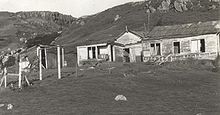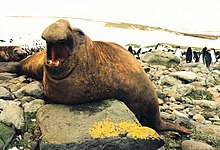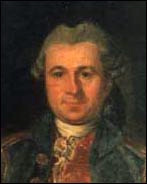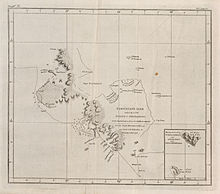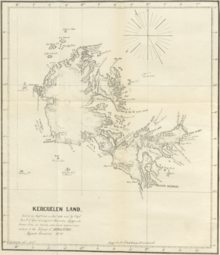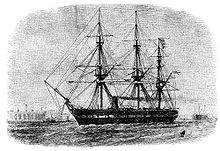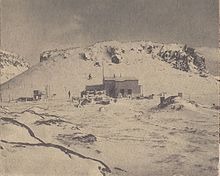Kerguelen
|
||
| Basic data | ||
|---|---|---|
| Administration: | French Southern and Antarctic Lands | |
| Research station: | Port-aux-Français | |
| Residents: | around 60, in summer 120 | |
| Geographical location: | 49 ° 20 ′ S , 69 ° 20 ′ E | |
| Surface: | 7215 km² | |
| highest elevation: | Mont Ross ( 1850 m ) | |
| longest fjord: | Baie de Recques (21 km) | |
| largest lake: | Lac Marville (25 km²) | |
| biggest island: | Île Kerguelen / Grande Terre (6675 km²) | |
| largest glacier: | Cook Glacier / Calotte Glaciaire Cook (403 km²) | |
| Currency: | Euro (EUR) | |
| Discovery: | February 12, 1772, by Yves Joseph de Kerguelen de Trémarec | |
| Website: | www.taaf.fr/-District-de-Kerguelen- | |

|
||
The Kerguelen Archipelago [ kərˈgeːlən ] (also "Kerguelen" or "the Kerguelen") is a sub-Antarctic archipelago in the southern Indian Ocean . It is located 1,261 km east of the Crozet Islands and 422 km northwest of the Australian outer area Heard and McDonald Islands .
The archipelago is part of the French Southern and Antarctic Lands . It has been named after its discoverer, the French rear admiral Yves Joseph de Kerguelen de Trémarec, since the 19th century .
With the exception of the Port-aux-Français research station , the Kerguelen Archipelago is uninhabited. The station was set up for permanent operation in 1949 and is located in the east of the main island on the Péninsule Courbet, on the Golfe du Morbihan.
In 2019, the archipelago was, as part of the -meere French Southern Territories and , for UNESCO World Heritage declared.
General
location
The archipelago is located in the southern Indian Ocean at latitude 49 ° south and longitude 70 ° east, 3981 km from Australia , 3782 km from the South African coast and about 2000 km from the Antarctic mainland .
The archipelago, like many of the sub-Antarctic islands a very remote region, can only be reached by sea to this day because there is no runway for airplanes. Due to the inaccessibility of the islands, most regions of the archipelago can only be visited by helicopter. The research and supply ship Marion Dufresne II , built in 1995, calls at the Kerguelen archipelago, the Crozet Islands and the islands of Saint Paul and Amsterdam from Réunion from November to March . The crossing on the 120.5 m long ship of the Institut Polaire Français Paul-Émile Victor (IPEV) takes an average of eight to ten days.
geology
The Kerguelen Archipelago is one of the oldest archipelagos in the world. It formed about 40 million years ago due to volcanic activity; a so-called plume lies beneath the archipelago in the earth's mantle . The islands are located on the Kerguelen Plateau , an underwater mountain range that protrudes 3700 m above the surrounding seabed. The islands are - with Heard and the McDonald Islands - one of the three places where the Kerguelen plateau and the larger Kerguelen-Gaussberg ridge rise above the surface of the water. The tremendous volcanic activity, which has repeatedly reshaped the islands in the course of the Earth's history, has weakened more and more since the beginning of the Quaternary .
Periodically recurring changes between cold periods and warmer phases, in which denser vegetation could develop, have since determined the plant and animal life on the Kerguelen Islands. Coal finds and plant fossils such as petrified tree remains suggest that forests even grew here under climatically more favorable conditions in the Quaternary.
The volcanic origin of the archipelago is particularly evident in the basalt sheets that cover around 85 percent of the archipelago and in some cases are 1,000 m thick. In many places in the table mountains, erosion by wind and water has created deep valleys, pyramid-like mountain tops or rock needles. Exposed volcanic intrusive rocks such as syenite primarily determine the geological composition of the southwestern peninsula of Rallier du Baty.
geography
The Kerguelen Archipelago has a total area of 7215 km², of which 6675 km² fall on the main island Île Kerguelen (Grande Terre). From the Îlot du Rendez-vous at the northernmost point to the Île de Boynes in the very south it is 174 km, to the west-east the archipelago extends from the Îles de la Fortune to Cap Ratmanoff 158 km. The mean height of the islands is 300 m. Their appearance, however, is characterized by wide basalt table landscapes from 400 to 600 m high. Fjords cut deep into the interior of the islands, which are criss-crossed by huge, partly glaciated valleys, which are bordered by steep slopes. Numerous volcanic peaks tower over the islands, including Mont Ross (Grand Ross: 1850 m, Petit Ross: 1721 m) on the Gallieni peninsula, the highest mountain in the archipelago, which was first climbed in 1975.
From the once complete glaciation of Kerguelen, only isolated ice caps have survived today. The largest is the Cook Glacier (Calotte Glaciaire Cook) covering the western part of the island with a total area of 403 km² in 2003 (six percent of the area of Grande Terre), which extends numerous glacier tongues into the surrounding valleys and bays. Large parts of the mountain massifs are also still glaciated around Mont Ross in the Massif Gallieni and around the mountain peaks on the Rallier du Baty peninsula.
The decline in glacier areas since the end of the last glacial period has left numerous very elongated glacial lakes , e. B. Lac d'Entr'Aigues (9 km²), Lac Bontemps (7 km²), Lac Hermance (6 km²) and Lac Sibelius (all in the Plateau Central between the Courbet and Jeanne d'Arc peninsulas). With an area of 25 km², Lac Marville is the largest, and is located at the northeastern end of the Courbet peninsula. The waning ice sheets have also left wide, sandy valley areas criss-crossed by rivers , which branch out in many ways and which extend mainly on the Rallier du Baty peninsula and around the foothills of the Cook Glacier.
Overall, the archipelago includes about 400 islands, of which to Grande Terre (German Big Country ), the Ile Foch and the Ile Saint-Lanne Gramont in the northern part of the island group are the biggest. The coasts are mostly rocky and drop off steeply. On average, the edges of the island are almost 200 m above sea level, in some cases they even reach heights of 800 m, such as at the Cap des Aiguilles (German needle cape ) and at the Cap du Challenger (both on the south coast of the Jeanne d'Arc peninsula).
Geographical breakdown
Islands
| Île Kerguelen (Grande Terre) | 1 | Île Foch | |
| 2 | Île Saint-Lanne Gramont | 3 | Île du Port |
| 4th | Ile de l'Ouest | 5 | Île Longue |
| 6th | Ile Howe | 7th | Ile Mac Murdo |
| 8th | Île Australia | 9 | Îles Nuageuses (Île de Croÿ, Île du Roland, Îles Ternay) |
| 10 | Îles Leygues (Île de Castries, Île Dauphine) | 11 | Îles du Prince de Monaco |
| 12 | Île Violette | 13 | Île Haute |
| 14th | Île Gaby | 15th | Île Altazin |
Peninsulas
| 1 | Peninsule Courbet | 2 | Peninsule Rallier du Baty |
| 3 | Peninsule Gallieni | 4th | Peninsule Loranchet |
| 5 | Presqu'île Jeanne d'Arc | 6th | Presqu'île Ronarc'h |
| 7th | Presqu'île de la Société de Géographie | 8th | Presqu'île Joffre |
| 9 | Presqu'ile du Prince de Galles | 10 | Presqu'île du Gauss |
| 11 | Presqu'île Bouquet de la Grye | 12 | Presqu'île d'Entrecasteaux |
| 13 | Presqu'île du Bougainville | 14th | Presqu'île Hoche |
Île Kerguelen (Grande Terre)
The main island Île Kerguelen (also Grande Terre ) has an area of 6675 km², which is about 92.5 percent of the total area of the archipelago. This makes it a good two and a half times the size of the Saarland or almost twice the size of Mallorca . The island measures about 134 kilometers from east to west and has a north-south extension of 120 kilometers.
What is particularly noticeable is the strong fissure of the island - a torn structure of several large peninsula foothills, some of which are only connected to the central island by filigree isthmuses , and which are in front of other smaller islands. Because of the coastline, which is often very deep, no point on the island is further than 21 kilometers from the sea.
Peninsule Courbet
The Courbet peninsula, named after the French admiral Amédée-Anatole Courbet (1827–1885), is the largest peninsula by area and characterized by a very uneven topography. While the mountainous west reaches heights of up to 979 m (Mont Crozier) and deeply cutting valleys divide the mountain ranges (Val Studer, Val de l'Ouest), the east rises only a little above sea level, and its partly sandy or gravel-covered shores show wide beaches like at Cap Ratmanoff. Lac Marville, located on the east coast, is the largest of the numerous lakes on Kerguelen.
The peninsula, which extends over 54 kilometers from west to east, is covered in the north by the Golfe des Baleiniers (German whalers' bay ) and in the south by the wide bay of the, with around fifty larger and smaller islands (e.g. Île Australia, Île Haute) Golf du Morbihan limited. The Golfe du Morbihan (700 km²) is quite well protected from the harsh climate of the archipelago; the up to eight kilometers wide strait of the Passe Royale connects it with the Indian Ocean.
Because of its protected location, the permanent French research station Port-aux-Français was built in 1949 on the Golfe du Morbihan. It was expanded by 1976 in order to be able to comprehensively research the islands scientifically. The station includes the Notre-Dame des Vents church and a hospital. About 60 people live and work here all year round; during the summer (December to March) the number of employees rises to around 120 people. There are individual gravel roads running in and around the station, they are the only roads on the island.
Presqu'île Jeanne d'Arc
The peninsula Jeanne d'Arc, named after the French national heroine and saint Joan of Arc (1412–1431), is only connected to the main island of Grande Terre by an isthmus of about 500 m and borders the Gulf of Morbihan in the south.
Wide high plateaus tower over narrow, damp, elongated valleys here. On the southern edge, the peninsula slopes down to the sea in a cliff lined with numerous cliffs and pinnacles and ends at Cap du Challenger, the southernmost point of the main island. The highest peaks are the Mont Tizard ( 844 m ) on the Baie des Licornes and the Mont Evans ( 718 m ) on the Baie Sauvage (German Wild Bay ). In the west, the peninsula borders the Baie des Swains with its two larger islands, Île Altazin and Île Gaby.
In the north-west of the peninsula is Port-Jeanne-d'Arc, a fishing and processing station built in 1906 by Norwegian whalers. The settlement consisted of four residential buildings with corrugated iron roofs and wooden walls, a stable, several boilers and other technical systems and later fell into complete disrepair. Extensive restoration work has been taking place since 2000.
Presqu'île Ronarc'h
The Ronarc'h [ ˈrɔnarx ] peninsula , named after the French admiral Pierre Alexis Ronarc'h (1865–1940), is connected to the Jeanne d'Arc peninsula in the south by a narrow isthmus, the Halage des Naufragés. The peninsula's mountain ranges drop from the central elevations of Mont Wyville Thomson ( 937 m ) and Mont Rouge ( 529 m ) to the sea. The 744 m high, conical volcanic ruin Le Pouce (German the thumb ) is particularly striking . On the northern edge of the Ronarc'h is Port-Douzième with a hut and a geomagnetic station.
Peninsule Gallieni
To the southeast of the Cook Glacier, the Gallieni peninsula ( Joseph Gallieni , 1849–1916, French general and minister of war) connects to the main island of Grande Terre. It extends over a length of 34 kilometers between the Baie des Swains and the Baie d'Audierne. The northern edge of the Gallieni is formed by Lac d'Entr'Aigues, Kerguelen's second largest lake by area. Large parts of the peninsula are characterized by the towering Massif Gallieni, which is crowned by the dominant double summit of Mont Ross ( 1850 m ) as well as the Dôme du Père Gaspard ( 1063 m ) and the Pyramid Noire ( 996 m ). Imposing basalt formations can be found numerous on the peninsula. Among them, on the western edge of the peninsula in the Baie Larose, protrudes the 235 m high Doigt de Sainte-Anne (German finger of Saint Anne ), at whose feet one of the largest king penguin colonies on the islands nests.
Peninsule Rallier du Baty
The south-western end of the main island is the Rallier du Baty peninsula, named after the brothers Henri (1879–1915) and Raymond (1881–1978) Rallier du Baty, who first carried out an exact map of the Kerguelen Islands. It is bordered by the Baie d'Audierne, dotted with many jagged peninsulas, and the wide Baie Bretonne. While the eastern part of the peninsula is characterized by wide valleys and flat moraine landscapes traversed by rivers, the west is criss-crossed by up to 1262 m (Mont Henri) high, partly glaciated mountain ranges. The retreat of the glaciers left large sandy plains in the east (e.g. Vallée des Sables) from which only a few mountain peaks protrude.
Peninsule Loranchet
Named after Jean Loranchet (1888–1966, first officer of the second Kerguelen expedition under Raymond Rallier du Baty), the peninsula Loranchet is difficult to access and lies in the north of Grande Terre. Fjords and bays cut deep into the interior and branch out in many ways (Baie de Recques, 21 km in length). The peninsula, which extends around 54 kilometers to the north, is separated from the Société de Géographie peninsula and the island of Saint-Lanne Gramont in the east by narrow straits, and from the Îles Nuageuses in the northwest by the Chenal du Jean-Baptiste Charcot.
At the northernmost point of the Loranchet in the Baie de l'Oiseau (German bird's bay ) is the historic geomagnetic station Port-Christmas, where James Cook anchored at Christmas 1776. The most famous rock formation of the archipelago used to stand at the southeast end of the small bay, the naturally formed, free-standing arch of the Ark des Kerguelen , which collapsed between 1908 and 1913. The rock stumps of the arch that have survived to this day still look impressive.
Presqu'île de la Société de Géographie
The 14 km long and 11 km wide "Peninsula of the Geographic Society", named after the Société de Géographie , founded in 1821 , is bordered by the Loranchet peninsula in the west and the Île Foch in the east. The partly glaciated mountain range is dominated by the peaks of Mont Richards ( 1081 m ) and Mont Pietri ( 941 m ).
Presqu'île Joffre
This peninsula, named after the French General Joseph Joffre (1852–1931), spreads out in a fan shape between the Île Foch in the west and the Île du Port in the south into the western waters of the Gulf of Baleiniers. The strong ruggedness of the main island is particularly evident on the Joffre Peninsula, and the numerous offshore islands and cliffs reinforce this picture. The mountain ranges of the peninsula reach their highest point in Mont Dr. Chaise longue ( 451 m ).
Presqu'île Bouquet de la Grye
The smaller Peninsula Bouquet de la Grye, named after Anatole Bouquet de La Grye (1827-1909), French engineer and President of the Académie des Sciences (1902), lies between the Cook Glacier in the west and the Courbet Peninsula in the east. The third largest lake on the islands, Lac Bontemps, belongs to it.
The former sheep breeding station Port-Couvreux, which is in a ruinous state today, is located at the east end of the 19-kilometer headland. From 1912, the breeding of these domestic animals was promoted here for settlement purposes, but had to be finally stopped in 1931.
climate
|
Average monthly temperatures and rainfall for Kerguelen
Source: Global climate normals 1961–1990 (CD-ROM, National Climatic Data Center)
|
||||||||||||||||||||||||||||||||||||||||||||||||||||||||||||
The climate is cold and windy, a consequence of the global north-south asymmetry (see note on Falkland Islands ). The average temperature of the warmest month (February) is 7.5 ° C, that of the coldest months (July / August) is 2.0 ° C. The annual average temperature is 4.5 ° C; temperatures rarely rise above 10 ° C in summer and rarely fall below −10 ° C in winter. Kerguelen has a decidedly oceanic climate. Winter temperatures are milder than in Germany, while summer temperatures are significantly cooler than in Iceland . The sea is mostly rough, mainly because of the remote location in the southern Indian Ocean and the constant westerly winds of the Roaring Forties . The frequent rainfall provides an average of only 708 mm over the year, a relatively low value.
The most noticeable weather phenomenon is the constantly blowing wind. The average wind speed is around 35 km / h, in storms speeds of more than 200 km / h are reached. There are storms about 150 days a year and hurricanes hit the islands on 41 days a year.
The climate has become milder and less harsh than at the time of the voyages of discovery in the 18th century. Today, icebergs can rarely be seen off the coast of the archipelago , and the decline in glaciation that began around thirty years ago has made regions of the islands accessible to which it was not possible to get to in the 1960s due to the permanent icing of individual mountain passes.
fauna
Since the first Kerguelen expeditions, humans have had a major impact on the archipelago's fragile ecosystem. The ruthless exploitation of the fauna, aimed at a constant increase in production, caused the population of seals and penguins to collapse. It was only with the restriction of unregulated fishing in the 20th century that the populations were able to regenerate; they are now subject to strict protection regulations.
Kerguelen is inhabited by an abundant and diverse bird population. These include penguins , petrels , albatrosses , skuas and species of cormorants such as the kerguelen shark or terns such as the kerguelen tern . A special ornithological feature is the Kerguelen duck ( Anas eatoni eatoni ), which is endemic to the Kerguelen Islands . The bird population is estimated to be around 10 to 20 million animals, around 18 percent of which are penguins.
Large king penguin colonies nest on the flat stretches of coast of the archipelago, such as in Baie Larose or on the Courbet peninsula on Cap Ratmanoff. Other species such as the golden crested penguins or rockhopper penguins live on the mountain slopes or in rock caves near the sea.
Among the mammals that populate the coasts of the archipelago, the elephant seals and other seal species stand out. The elephant seals come to reproduce on the beaches in the southern summer. The males often fight over the females. Besides them, there are other Antarctic seals living in the coastal waters, e.g. B. Leopard seals .
Fin whales , sperm whales , killer whales and dolphins dominate among the whales in the surrounding sea waters , including the endemic subspecies of the Commerson's dolphin ( Cephalorhynchus commersonii kerguelenensis ), which lives 8,500 kilometers from the range of the nominate form in South America and is strong with only a few individuals is considered endangered.
Several flightless species of flies and butterflies live on the archipelago.
Alien species have been introduced there since the Kerguelen Archipelago was discovered. Whalers brought many domestic animals such as cats and rabbits with them in the 19th century. The latter have adapted to local conditions and in winter only feed on seaweed washed up on the sea. The first attempts at breeding sheep failed, but the first successes have been achieved since the 1950s. In addition to the sheep, reindeer were also introduced from Lapland . The cats in particular, whose population is estimated at around 15,000 animals, endanger the population of the native birds.
flora
The vegetation on the Kerguelen Archipelago is sparse and tundra-like . The unfavorable climatic conditions, especially the frequent strong storms, only allow dwarf shrubs to thrive in particularly sheltered locations. There are no trees. Mainly dense, low grass areas cover the coastal areas up to about 50 m above sea level. At higher altitudes, scattered tufa sediment surfaces covered with moss and lichen determine the landscape. These sub-Antarctic meadows differ significantly from the typical tundra climate with a milder climate and lack of permafrost, although the vegetation is quite tundra-like in character. The assignment of vegetation is therefore inconsistent in the literature.
More than 150 different species of lichens, around 60 of which are endemic , are the most common floral elements found on the islands. In flat terrain or near streams, the soil is often moist and swampy. There the vegetation is dominated by peat- like moss areas. The mosses often form self-contained, compact surfaces and sometimes cover very loose, sloping terrain. This harbors dangers for the hiker, because he can sometimes sink up to the waist into the puddles of water hidden below.
Very common plant species are acaena ( Acaena ) and Azorella selago . Azorella selago , like Lyallia kerguelensis ( Montiaceae ), which is endemic to Kerguelen, is a cushion-like network-forming plant. The Azorella cushions can reach a thickness of one meter and are mainly found as a cohesive, net-like network. It is very difficult to walk on this soft, loose vegetation without slipping. For the many sea birds, on the other hand, the cushions are ideal for digging nests, as they protect the nest.
A remarkable plant is the Kerguelenkohl ( Pringlea antiscorbutica ) that thrives on the islands , the scientific name of which indicates its use; By consuming it, seafarers used to protect themselves against scurvy because the plant contains a lot of ascorbic acid . The introduction of land mammals has had serious consequences for the vegetation, as mice and rabbits have reduced the once large stocks of the native kerguele cabbage, and because they even consume the seeds, it is difficult for it to regenerate naturally. In the regions populated by rabbits, the dandelion is also a common plant that is not known to have had any significant distribution on Kerguelen before the rabbits were introduced.
In contrast to the sparse vegetation on land, the marine flora in the waters surrounding the islands is rather lush. Among them, the gigantic brown algae Macrocystis ( Macrocystis pyrifera ) and the Durvillaea antarctica , which seem to form impenetrable carpets of algae and cover large parts of the rocky coast, stand out.
history
18th century
Yves Joseph de Kerguelen de Trémarec
The French navigator Rear Admiral Yves Joseph de Kerguelen de Trémarec (1734–1797) discovered Kerguelen on February 12, 1772 on his first voyage. It was the second great French expedition to the Indian Ocean; on January 25, 1772, driven away by the storm, Marc-Joseph Marion du Fresne (1724–1772) landed on the neighboring Crozet Islands .
King Louis XV had commissioned de Kerguelen to find the unknown southern continent Terra Australis and to establish relationships with its supposed inhabitants. De Kerguelen began his expedition on the island of Île-de-France, today's Mauritius , from where he set sail with the ships Fortune and Gros Ventre on January 16, 1772. A safe landing on the stormy west coast of the hard-to-reach Kerguelen Islands seemed impossible. De Boiguehenneuc, the officer of the Gros Ventre , however, managed to go ashore on the southwest tip of the main island (in the bay of Anse du Gros Ventre) and take possession of it. Under the extreme weather conditions of the archipelago, the ships eventually lost visual contact and were separated. On March 27, 1772, de Kerguelen reached French soil again , long before the Gros Ventre returned.
De Kerguelen named the islands La France Australe (German: France of the South ), convinced that he had discovered the long sought-after southern continent . Since he described it to the king as a rich, densely populated country, he was finally commissioned for a second mission, which he began on March 26, 1773. This time, de Kerguelen traveled with three ships, the Roland , the Oiseau and the Dauphine to Austral-France, which finally left the port on Réunion on October 28, 1773 to head for their actual destination.
On January 30, 1774, Lieutenant de Rochegude succeeded in setting ashore in the Baie de l'Oiseau (named after his ship). The unfavorable climatic conditions, scurvy and deaths finally forced de Kerguelen to return home without ever having entered the islands that were later named after him. On September 7, 1774, the ships reached France again. De Kerguelen was convicted by a military tribunal in 1776 for failure to provide assistance and for the unprofitable results of the expedition and has since spent several years in prison with interruptions. He died in Paris in 1797.
James Cook
James Cook (1728–1779) explored the southern Indian Ocean on his second South Sea expedition with the ships Resolution and Adventure and was finally able to refute the theory of the existence of a habitable southern continent. The German naturalist, ethnologist and travel writer Georg Forster (1754–1794) accompanied Cook with his father Johann Reinhold Forster (1729–1798) on board the Resolution on this circumnavigation. The aim of this expedition was, among other things, the newly discovered islands of the sub-Antarctic waters. However, the ships missed Kerguelen in the adverse weather conditions, they were separated in the thick fog and continued their journey towards New Zealand . The following travel diary entries are examples of this:
"On the 2nd unsuccessful attempt by the Lord of Kerguelens Eiland to look for at 48 ° 36 'south latitude and 60 ° ± east longitude."
"On the 8th, the Adventure parted from us for the first time during a fog."
Cook's third voyage with the ships Resolution and Discovery led again across the southern Indian Ocean and headed from the Cape of Good Hope via the Prince Edward Islands and Crozet Islands to the Kerguelen Islands, where Cook on December 25, 1776 in the Baie de l'Oiseau dropped anchor. He named his landing site after the day of arrival: Port-Christmas. Cook calls the archipelago the Islands of Desolation , but finally gives them the name of their discoverer:
"I could have very properly called the island Desolation Island to signalize its sterility, but in order not to deprive M. de Kerguelen of the glory of having discovered it, I have called it Kerguelen Land."
The voyage to the Southern Sea was primarily for scientific purposes. Large parts of the island have been mapped and at least twenty native plant species have been discovered and recorded.
In 1799 Robert Rhodes explored the northeast coast of Kerguelen for eight months on board the sealer Hillsborough on behalf of the British East India Company ; he provided supplementary and comprehensive records and detailed maps of the coastal areas of the islands.
19th century
After the discovery of the Kerguelen Archipelago, the first whale and seal hunters arrived to secure the rich fishing grounds. The first American whalers landed on the islands as early as 1791/92 with the ships Alliance , Asia and Hunter , but stayed only a few months to hunt fur seals . In 1804/05 they were followed by British sealers and decimated the population to such an extent that as early as 1817 the crew of the British sailor Beagle could only find four living animals.
Four survivors of the English whaling ship Favorite spent 27 months beginning in the summer of 1825 at changing places on the main island until they were discovered and rescued by the whaler's crew, Sprightly . The report of the stay on the island, written by the leader of the castaways, John Nunn , was published as an illustrated book in 1850. The book was accompanied by an improved map of the Kerguelen Archipelago.
In 1997, the TAAF administration issued a 20-franc postage stamp to commemorate the wreckage and the construction of the shipwrecked shelter. The headquarters of the castaways was at Pointe Charlotte (coordinates: −49.299953, 70.532227 or 49 ° 17 ′ 59 ″ S, 70 ° 31 ′ 56 ″ E).
Tran , which was obtained primarily from the fatty tissue of marine mammals, was an important raw material for the manufacture of lamp oil and lubricants until petroleum was used . After the extraction of whale fat from whale blubber did not bring in the hoped-for amount, they specialized in the blubber of elephant seals. The British whaler George Howe won around 3000 barrels of the valuable oil in 1835–1840 , and from 1838–1840 even 3700 barrels could be processed by American catchers. Penguins or their feathers were burned to heat the trans.
The harsh living conditions of these early whale and seal hunters resulted in numerous seafarers' lives. Many of the graves are no longer preserved or cannot be found today. In the Baie Norvégienne lies the final resting place of the captain of the Duke of Portland , John Matley († 1810), who died of natural causes on a headland .
In 1840, James Clark Ross landed on the Kerguelen Archipelago with the ships HMS Erebus and HMS Terror . He too anchored in the Baie de l'Oiseau and stayed on the island from May 5 to July 29, 1840.
In 1874/75 more research ships visited the islands in order to observe the transit of Venus on December 9, 1874, which gave scientists the rare opportunity to calculate the exact distance between the earth and the sun. During this time, several observatories were set up . An American expedition under the command of GP Ryan established a small observatory on September 7, 1874 at Pointe Molloy in the southwest of the Courbet peninsula. A German research group brought to the island by the warship SMS Gazelle under Georg Gustav Freiherr von Schleinitz (1834-1910) founded an astronomical and geomagnetic observation base in Anse Betsy (northwest coast of the Courbet peninsula) on October 26, 1874.
From January 7 to 31, 1874, the British Challenger Expedition with the eponymous steamship under the command of Captain George Nares (1831-1915) carried out extensive oceanographic research and observation work, including on Kerguelen. The scientific management of the expedition took over the zoology professor Charles Wyville Thomson (1830-1882).
In 1877 an attempt was made to mine the existing coal deposits on the island, but this was given up because of the poor quality of the coal.
The frequent presence of whaling and sealing companies of British, American and Australian nationality undermined the French claims to ownership of Kerguelen, which could be justified with the first discovery of the islands in 1772. In order to underpin the territorial claims, the French government ordered the official seizure of Kerguelen, which was carried out by an expedition on board the L'Eure in the Baie de l'Oiseau on January 1, 1893. On January 7th there was a second ceremony at which a supply point was set up for the castaways.
20th century
1901–1903 the islands were a target of the Gauss . The crew of the ship of the German Antarctic expedition under Erich von Drygalski (1865-1949) set up a geomagnetic and meteorological observation station in the Baie de l'Observatoire (German observation bay ). The station was created in part from the beams and boards of the crumbling shelter of the English research group who observed the Venus transit of 1874.
The German mountaineer, meteorologist and expedition participant Josef Enzensperger (1873–1903) took over the management. In his Kerguelen diary he describes the sometimes harsh living conditions, adverse weather conditions and physical suffering of the researchers. Regardless of the hardships, he also finds positive words for the unique sub-Antarctic landscape. He describes the arrival with the second ship Tanglin , which was sailing independently of the Gauss , as follows:
"11. November [1901]. It is achieved! But we still had to buy it hard. What we saw at sea on the 7th of this month turned gray, and everything that went on the ship believed that they had never seen anything like it. […] [T] these incredible wave peaks! I measured those twelve meters high. [...] The captain [...] felt a load of stone when the outlines of a high country peeled out of the thick fog, [...] and in glorious sunshine we drove into a wonderfully beautiful fjord landscape.
[...] The contrast between the countless islands, the blue water that penetrates deep into the land in an infinite number of arms, the steep peaks of the basalt mountains and the ice-covered interior of the island is overwhelmingly beautiful. It's a shame that the average horrible weather so rarely allows you to enjoy this picture! [...] "
Enzensperger died on February 2, 1903 of beriberi , a disease caused by a vitamin B 1 deficiency. His grave, which cannot be found today, was located near the former station.
The brothers Henry (1859–1941) and René Bossière (1857–1941) founded the Compagnie Générale des Îles Kerguelen in 1908, which operated between 1908 and 1929 with interruptions. They also tried to breed sheep on Kerguelen, but failed because of the unfavorable climatic conditions for the animals.
The company granted the Norwegian whaling company A / S Kerguelen the fishing rights on the islands, which in 1908 established a whale and seal fishing station in Port-Jeanne-d'Arc on the peninsula of the same name. Between 1908 and 1911 442 whales were caught and only 13,760 barrels of oil extracted. By specializing in catching elephant seals, higher yields could be achieved, and 17,000 barrels of oil could be produced in 1911/12.
The brothers Henri and Raymond Rallier du Baty, who led their own expedition with the ship J. B. Charcot to the Kerguelen Islands in 1908/09, made great contributions to the scientific exploration of the archipelago . In 1913/14 Raymond Rallier du Baty (1881–1978) headed for the islands again with the Curieuse . The zealous brothers owe the first comprehensive descriptions of the archipelago, as they collected important and accurate hydrographic, geological and geographical data that contributed significantly to the publication of the first complete map of the Kerguelen archipelago in 1922.
In 1929/30 a British-Australian-New Zealand expedition under Sir Douglas Mawson (1882-1958) traveled with the RRS Discovery to the Kerguelen Islands. The Swiss Edgar Aubert de la Rüe (1901-1991) opened up new knowledge about the morphology, geology, flora and fauna of the islands through his research trips with the Austral between 1928 and 1952 and published the results in his study Etude Géologique et Géographique de l'Archipel des Kerguelen (1932).
Second World War
Kerguelen was not spared the effects of the Second World War either. The fjords and bays, which cut deep into the interior of the island, offered ideal hiding places for German warships.
In 1940 the German auxiliary cruisers Pinguin , Atlantis and Komet headed for Kerguelen for supply purposes and repair work. The sailor Bernhard Herrmann (1919–1940) had a fatal accident while repairing the Atlantis . He was buried on the island at Havre du Beau Temps (south of the Presqu'île Bouquet de la Grye). His burial place is the southernmost German soldier's grave .
The possibility that German submarines could be stationed on Kerguelen prompted the Allies to mine some of the anchorages with HMAS Australia , which kept the Germans away from the island and was able to preserve its relative unspoiltness. However, some of the bays are still dangerous for shipping today.
Part of the French overseas territory
From 1947 to 1954, the islands were a regular destination of the Australian National Antarctic Research Expeditions (ANARE). Thus, the French government felt compelled to secure its already existing territorial claims to Kerguelen permanently.
In December 1949, the French set up the permanent research station in Port-aux-Français on the Golfe du Morbihan, under the direction of Pierre Sicaud (1911-1998) . Because of the enormous distance to France, the administration of the islands was transferred to the French Governor General of Madagascar in 1924 . Even before the Southeast African island state gained independence in 1960, France formed an overseas territory ( Terres australes et antarctiques françaises ) in 1955 , consisting of the Crozet Islands , the Île Saint-Paul , the Île Amsterdam , the Kerguelen Archipelago and the Terre Adélie on the Antarctic continent .
Research on geology, volcanology , seismology , petrology , meteorology, oceanography and hydrography as well as medical, biological, zoological and ichthyological research form the main part of the scientific work on Kerguelen .
In addition to the Marion Dufresne II as the main transport and supply ship overseas, the scientists use a smaller ship from the Institut Polaire Français Paul-Émile Victor (IPEV), the NO La Curieuse , to provide logistical support for the research programs at points in the archipelago that can only be reached by ship. Moreover, it makes use of inflatable boats to be able to travel to shorter distances to water. In addition to scientists and assistants, a certain number of tourists are allowed to accompany the Marion Dufresne II's journey to Kerguelen, among other places. However, this venture turns out to be extremely expensive and time-consuming, as the ship only calls into the French Antarctic territories from Réunion.
Between 1963 and 1981, research missiles were launched from the Courbet Peninsule (more precisely: 49 ° 22 ′ S, 70 ° 14 ′ E), mainly Soviet M-100s, as well as Arcas , Dragon and Eridan . In addition, the French space agency Center national d'études spatiales (CNES) has been maintaining a base on Kerguelen since 1992 for receiving telemetry data from the Ariane rockets launched from the Kourou spaceport ( French Guiana ). The base is about four kilometers from Port-aux-Français.
Others
The Kerguelen Islands are the starting point of the research trip in Jules Verne's novel The Ice Sphinx . This is a fictional trip to the Antarctic regions. The novel is a sequel to Edgar Allan Poe's The Narrative of Arthur Gordon Pym of Nantucket .
Patrick O'Brian uses the name Desolation Island, used by Cook for the main island, for his book of the same name (German: Sturm in der Antarktis ). The island serves as a refuge here for his fictional character, Jack Aubrey, to repair his ship.
In the submarine thriller Kilo Class by Patrick Robinson , the Kerguelen Islands are found also. Taiwan has a secret base there to build an atomic bomb to keep China in check.
The single-handed sailor Isabelle Autissier suffered a broken mast with her 18-meter yacht Ecureuil Poitou-Charentes II at the BOC Challenge 1994–1995 about 1000 nautical miles from the Kerguelen Archipelago, then headed for Port-aux-Français and received a new mast there. As she continued her journey, she lost the boat a few hundred nautical miles further due to a hull damage and had to be rescued by helicopter.
During the one-handed non-stop regatta Vendée Globe 2008/2009 , the keel suspension broke on the boat Temenos II of the Swiss participant Dominique Wavre south of the Kerguelen archipelago, so that he had to give up the race on December 13, 2008 and headed for Port-aux-Français in order to temporarily repair the suspension and to be able to sail on at least as far as Australia on our own. On the same day, the second Swiss participant, Bernard Stamm, found damage to the rudder suspension on his boat Cheminées Poujoulat , which also forced him to call at Port-aux-Français. When docking, a storm front with gusts of up to 60 knots pulled over the archipelago and drove the boat towards the rocks. Stamm took refuge in the boat's life raft and the yacht hit the rocks. It was recovered the next day, badly damaged. The French participant Loïck Peyron suffered a broken mast two days earlier - while in the lead - on his Gitana Eighty , a boat sponsored by the LCF Rothschild group , 650 nautical miles west of the Kerguelen archipelago. He decided to sail to Perth with an emergency sail to try to repair the mast there instead of calling at Port-aux-Français. The attempt failed: five days later he had to give up.
literature
- Max Schmid, André Giret: Kerguelen . Birkenhalde Verlag, Winterthur 1998, ISBN 3-905172-17-8 .
- Jeff Rubin: Antarctica . Lonely Planet Publications, Victoria 2000, ISBN 978-0-86442-772-4 (English).
- Erich von Drygalski : To the continent of the icy south . Georg Reimer Verlag, Berlin 1904, ISBN 3-86539-856-1 .
- Jean-Paul Kauffmann: The Arch of Kerguelen: Voyage to the Islands of Desolation . Four Walls Eight Windows, New York 2000, ISBN 1-56858-168-8 (English).
- Robert Holzner: An archaeological investigation on Kerguelen, Sub-Antarctica - The ArchaeObs project - . In: Polar Research . tape 78 , no. 1/2 , 2009, pp. 55-66 , doi : 10.2312 / polar research . 78.1-2.55 .
- Robert Eyssen : HSK Komet - pirate voyage on all seas . Koehlers Verlagsgesellschaft, Hamburg 2002, ISBN 3-7822-0856-0 .
- Patrick Robinson: Kilo Class . Wilhelm Heyne Verlag GmbH & Co. KG, Munich, ISBN 3-453-19981-2 .
- Alan Sillitoe : Verschollen - The lost flying boat . Gustav Lübbe Verlag, Bergisch Gladbach 1987, ISBN 3-7857-0472-0 .
- WB Clarke: Narrative of the wreck of the “Favorite” on the island of Desolation: detailing the adventures, sufferings and privations of John Nunn . William Edward Painter, London 1850 (English, as digitized version - approx. 80 MB).
Web links
- District de Kerguelen. Official website. In: taaf.fr. Administration des Terres australes et antarctiques françaises (TAAF) (French).
- Kerguelen archipelago. Institut polaire français Paul-Émile Victor (IPEV) (French).
- Kerguelen - Island of Desolation. With an illustrated expedition report and an extensive thematically structured link list. In: kerguelen.de - Everything about the Kerguelen! Michael Kracke.
- Dominique Weis: Kerguelen Archipelago (TAAF) (Indian Ocean). Volcanism and Kerguelen Plume. Université libre de Bruxelles - Département des Sciences de la Terre et de l'Environnement (English).
- Kerguelen in the Encyclopedia Astronautica (English), with a list of rocket launches
- Kerguelen Islands, Part 1 and Part 2. In: discoverfrance.net. Ian C. Mills (English).
- Kerguelen, Terres Australes et Antarctiques Françaises, TAAF. In: kerguelen-island.org (French).
- ONC T-6 Iles Kerguelen; Heard Island; McDonald Islands; Indian Ocean . In: US Defense Mapping Agency Aerospace Center (Ed.):Operational Navigation Charts 1: 1,000,000. Perry-Castañeda Library Map Collection of theUniversity of Texas at Austin(JPG; 6.63 MB, English).
- Îles Kerguelen. Topographic map 1: 200,000 with zoom function. In: Géoportail . Institut national de l'information geographique et forestière (IGN) (French).
- Expeditions - ArchaeObs. Trilingual report on an archaeological prospecting and excavation of the remains of the Kerguelen station of the Gauss expedition 1901–1903. In: anciensite.taaf.fr. Administration des Terres australes et antarctiques françaises (TAAF) (French, English, German).
Individual evidence
- ^ French Austral Lands and Seas. UNESCO World Heritage Center, accessed July 8, 2019 .
- ↑ La fonte spectaculaire du plus gros glacier français. Press release. In: Environnement - Actualités - Cryosphère. Institut national des sciences de l'univers (INSU), Center national de la recherche scientifique (CNRS), July 21, 2009, accessed on May 15, 2017 (French).
- ↑ Les étapes de la restauration. In: Patrimoine des TAAF - Port Jeanne d'Arc station. Transpol'aire - L'aventure polaire, accessed on May 15, 2017 (French).
- ↑ Commerson Dolphin. In: Whale and Dolphin Conservation Germany. Accessed June 3, 2020 (German).
- ^ Heinrich Dathe , Paul Schöps: Pelztieratlas . VEB Gustav Fischer Verlag, Jena 1986, p. 89.
- ↑ Georg Forster (ed.): Johann Reinhold Forster's [...] collected remarks on objects of the physical description of the earth, natural history and moral philosophy on his journey around the world. Haude and Spener, Berlin 1783, Diary of the trip around the world, p. (6). Full text in Google Book Search.
- ^ WB Clarke (ed.): Narrative of the wreck of the “Favorite” on the island of Desolation: detailing the adventures, sufferings, and privations of John Nunn. William Edward Painter, London 1850 (English, full text in the Google book search or as PDF , 8.93 MB).
- ^ "Hope Cottage" stamp . In: discoverfrance.net. Ian C. Mills, accessed December 17, 2016.
- ↑ Josef Enzensperger. Alpine essays and lectures, travel letters and Kerguelen diary. In: A mountaineer's life. ed. from the Academic Alpine Association Munich, 2nd increased and modified edition, Munich 1924, travel letters, p. 255 f.
- ↑ Kerguelen war cemetery / Indian Ocean. In: war cemeteries. Volksbund Deutsche Kriegsgräberfürsorge e. V. , accessed on May 15, 2017 .
- ^ Participation à une rotation australe du Marion Dufresne. In: taaf.fr. Administration des Terres australes et antarctiques françaises (TAAF), accessed December 17, 2016 (French).
- ↑ Annette Bruhns : Isabelles Freiheit. The best single-handed sailor in the world. In: SPIEGEL SPECIAL 6/1996. Spiegel-Verlag Rudolf Augstein GmbH & Co. KG, June 1, 1996, ISSN 1612-6017 , pp. 60-62, accessed on December 17, 2016.









